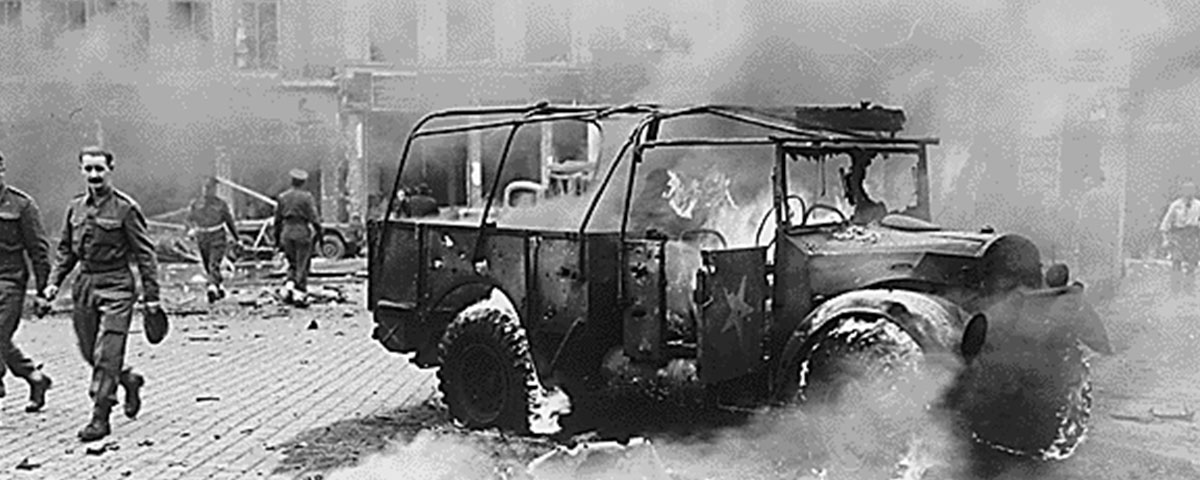As 1,100 Belgian citizens and Allied soldiers enjoyed a Saturday matinee, a blinding flash initiated the most devastating strike from a single air ordnance during the European Theater.
The liberation of Antwerp by the Allies in September 1944 set off a joyous frenzy among its citizens. Crowds filled the streets to dance, drink, and lavish flowers and affections upon passing Allied soldiers. The taste of freedom was intoxicating, the release from oppression euphoric. Then strange explosions began.
Within a month, monstrous blasts detonated like dropped bombs but without any hint of bombers overhead. Nor were these explosions foreshadowed by the deep, pulsating rumble people associated with incoming V-1 Buzz Bombs. The blasts’ randomness charged the air with terror. Newspapers censored any mention of them in an effort to fend off panic.
A Secret Operation
In eastern Netherlands 150 miles northeast of Antwerp the German soldiers sudden appearance one night distressed the local Dutch. Hundreds of troops entered the Hellendoorn area to encamp deep within local forests. While soldiers cut clearings, SS officers ordered Dutch residents to open their homes to the German troops.
The following night, a heavily guarded SS train of one hundred cars rolled onto a siding nearby. Massive, tarpaulin-wrapped cylinders on flat cars were offloaded with mobile cranes and set onto road transporters for travel south to the forests around Eelerberg.
For the local Dutch, the nature of the secretive German operations remained a mystery until mid-November when the first rocket rose above the local treetops. The armed V-2 had been airborne only a few seconds when it veered off course and tumbled to the ground in a deafening blast that shattered windows and roof tiles, including those of a tuberculosis sanatorium, where glass shards impaled patients and staff and sent the horror-stricken scrambling for exits.
Averaging four launches per day, locals heard a thundering roar creating sustained ground tremors the uninitiated thought were earthquakes. Smoke clouds then rose above the treetops through which rockets passed on pillars of flame. Many who saw these for the first time were terrified.
December 16, 1944
The SS Launch Battery hoisted their rocket onto a square launch platform and its electrical cable was attached to a launch control vehicle, a heavily armored hybrid designed to protect the three-man crew if an explosion occurred. The fueling tankers pulling away left hoses and attachments coated in a shimmering frost as a thin cloud of white vapor hovered around the rocket’s midsection.
A sharp pop and ensuing sputtering sounds erupted into a continuous thrust. When thrust attained twenty-five tons, the missile rose hesitantly from the launch table. Within thirty seconds it reached the speed of sound and arced toward Antwerp, sending off cheers from the SS Launch Battery. The launches were meant to stall the Allied invasion by destroying Antwerp’s harbors. The invasion could not survive without this logistical lifeline.
A Bright Flash
When seven-foot, chalice-shaped combustion chambers turned up in the rubble of the explosions authorities realized German rockets were raining down. The Belgians, however, refused to relinquish their joy of liberation. One of their most anticipated escapes was inside one of the city’s cinemas.
On a cold, mid-December Saturday, the 1,120 seats of the Rex Theater quickly filled with Belgian citizens and Allied troops eager to see Gary Cooper and Jean Arthur in the Hollywood Western, The Plainsman. Soon the crowded lobby was seasoned with the odors of popcorn and hot chocolate.
The V-2 launched from Hellendoorn touched the edge of space in sixty-five seconds. Its engine sputtered and went silent, tipping the 48-foot long, 17,000-pound missile into free-fall. Attaining the velocity of a rifle’s bullet, the V-2’s plunge toward impact was unannounced and unseen.
At 3:20 p.m., the darkened theater erupted in a blinding flash as the V-2 pierced the roof at three times the speed of sound. A thunderous detonation was followed by a sonic boom. Ceiling and balcony collapsed, walls tumbled inward, and the movie screen plunged into the front seats.
Pulverized concrete and plaster rose in a mammoth cloud that rolled expansively across the district to blanket it in a suffocating powder. Cries erupted within the avalanche of concrete and twisted steel forming a mountain of smoldering debris. In outer sections of the theater, many of the dead were sitting placidly in their seats, killed instantly by the blast wave.
Surrounding heat compromised a massive steam boiler generating warmth for the December day. When the pressurization failed, the boiler water flashed to steam, expanding to 1,600 times the volume of water in just a fraction of a second. The explosion was powerful enough to lift much of the rubble pile and fatally scald rescuers and many of those trapped.
Rescuers worked six days to uncover the last victim. Five hundred and sixty-seven people perished and nearly seven hundred were injured. It was the most devastating strike from a single airborne ordnance during the entire European Theater. People who could afford to do so left the city. Others ventured outdoors only when necessary. The bustle of Antwerp dwindled. TIME magazine would label Antwerp “The City of Death.”
One Giant Leap
Germans soon witnessed their flame of hope flicker in the tempest of Allied invasion. By May the Reich would collapse. Though only thirty percent of the rockets targeting Antwerp ever reached the city, the six-month barrage hurled 1,600 V-2’s killing 4,000 and injuring 6,000. More people died making the rockets than in being targeted by them — namely the estimated 20,000 slave laborers brutalized during its manufacture. The rocket’s greatest legacy came after the war as the forerunner to NASA’s Saturn V rocket.
It is no small irony that the most malevolent ideological scourge in history unlocked the gateway to outer space — what may yet become mankind’s greatest odyssey and, perhaps, its final passage to survival.





